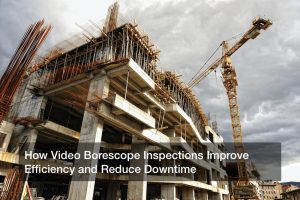

Industrial equipment and machinery require regular evaluation and inspection. This is where borescope comes in handy. A Borescope is an optical device used when visual inspection is limited without damaging the equipment of interest. A nondestructive testing technique requires borescopes to show imperfections or defects. Borescope inspection prevents unnecessarily repairs and maintenance costs that can be very high for large turbines. The equipment helps to inspect surface finishes, through holes and interior surfaces. Borescopes are also useful in building inspection and law enforcement forensic applications. Sometimes, optical fibers enclose this optical device.
Borescope Inspection
Borescope consists of flexible or rigid tube with an eyepiece fitted on one end and objective lens on the other. An optical relay system is used to link the two lenses. The objective lens forms an internal image of illuminated object. The eyepiece magnifies the image and portrays it to the eye of the viewer.
Borescope inspection can be used in numerous industrial procedures. These inspection instruments are, however, commonly used in gas turbine inspection. Since gas turbine operates under high temperatures, visual inspection can prove to be very dangerous. To be precise, gas turbines operate at 2,000 degrees Fahrenheit. Borescope allows inspection companies to inspect gas turbines safely. It enables visual inspection while preventing accidents from turbine heat. A nondestructive testing technique requires borescopes to show imperfections or defects.
Borescopes are used in visual inspections of automotive, engines, industrial parts, and turbines to meet the maintenance, quality, and safety requirements. However, the major reason for using borescope is because the areas cannot be inspected by other means. Similar devices used in medical industries are known as endoscopes. Doctors use endoscopes for internal inspection of human body. Imaging or video devices can be integrated into Borescopes.
Types of Borescope
Borescopes are categorized into three main groups.
- Video Borescopes
- Rigid Borescopes
- Flexible Borescopes
Video borescopes
Video borescopes are also referred to as inspection cameras. A miniature video camera is fixed at the flexible tube end. Light is fixed at insertion tube end to enable capturing still images and capture videos inside the engine, equipment, and dark spaces.
Video borescopes are used as remote visual inspection tools to capture images and video for later inspection. The other end display provides a camera view. The interesting thing is that you can change the viewing position with the joystick. The latest models provide adjustable illumination, better resolution, and lower cost.
Flexible Borescopes
Flexible borescope, also known as fiberscope consist of optical fiber that splits image into pixels. It is used to inspect cavities located on bends for example a combustion chamber. This allows inspection of turbine blades conditions and compressed air inlet without having to disassemble the engine. The image quality varies significantly across different models depending on fiber image guide construction and number of fiber. High-end models allow evaluation of size of the problematic area. Articulation range and components of articulation mechanism are some important factors in flexible borescopes. While flexible borescope does not provide the best picture quality, they are very useful in hard to reach places. Due to the image quality and cost constraints, flexible borescopes are not common in large machinery and turbines.
Rigid Borescope
Rigid borescope has relative better quality images than fiberscope at a lower cost. One limitation of these borescopes is that viewed objects must be in a straight line. They are, therefore, ideal for fuel injectors, gunsmithing, hydraulic manifold bodies, and automotive cylinders.
Rigid borescopes have three basic types of optical systems. These include achromatic doublets, Harold Hopkins rod lenses, and gradient index rod lenses. When selecting a rigid borescope, some of the important consideration includes access and clarity. The instrument that fits the hole provides the best image. A rigid borescope is very affordable compared to the other types. Since they have little flexibility, they are used in areas that have direct access. Borescope services companies use rigid boroscopes for inspection due its durability and image clarity.
Generally, borescopes are easy to use. These devices provide optimal image of large machinery and gas turbines. The different borescope type provides numerous benefits during visual inspection. These advantages include detailed and accurate coverage, and high-resolution pictures to cover places that are difficult to reach. Also, borescope inspection devices help to retrieve foreign objects.





